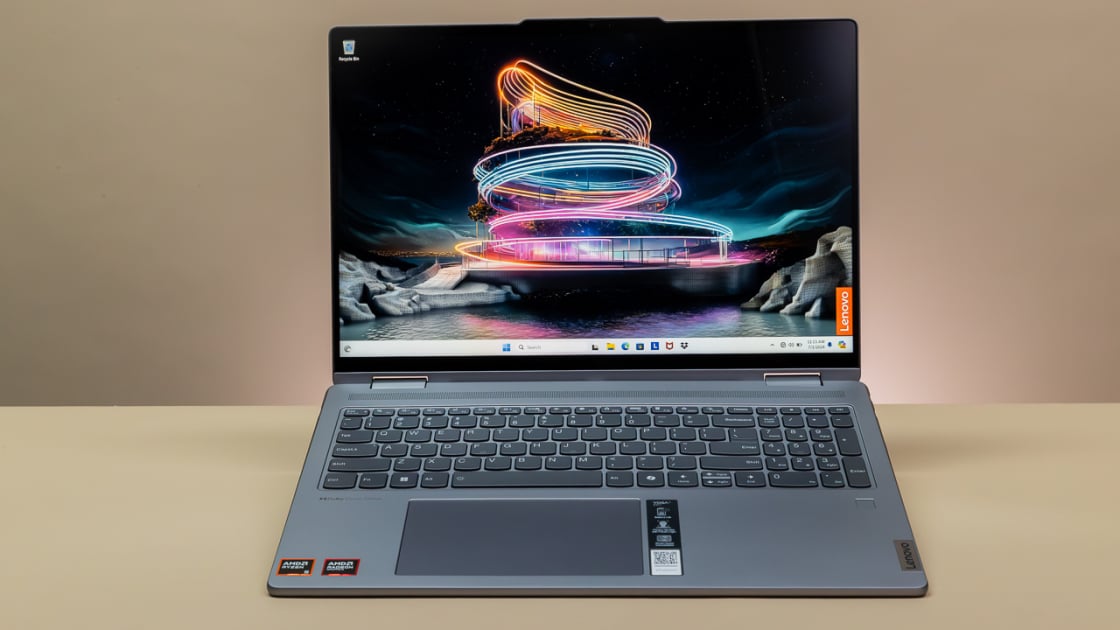Lenovo Yoga 7 2-in-1 Gen 9 (16-inch): Big on Size, Short on Substance

The Lenovo Yoga 7 2-in-1 Gen 9, powered by AMD, falls short of expectations despite its sleek metallic design and comfortable input devices. This 16-inch laptop (£749 as reviewed) proves too cumbersome for its convertible design, with its hefty weight hindering its tablet functionality. Additionally, its underwhelming screen and meagre 8GB of RAM significantly detract from the user experience. While its battery life is decent, it doesn't stand out among its competitors. Ultimately, better options exist for mainstream productivity on a larger screen, such as the Acer Swift Go 16.
#
Design: Stylish Yet Bulky
Lenovo's Yoga laptops pioneered rotating screens, allowing them to transform from laptop to tablet mode. However, this feature feels more like a novelty than a genuine advantage on a 16-inch model. Weighing in at a hefty 2.1kg, this 2-in-1 becomes a substantial burden to carry around, as do its competitors, the 2kg Yoga 7i (Intel version) and the 2.2kg Dell Inspiron 16 2-in-1 (model 7640) currently under review. In stark contrast, the non-convertible Acer Swift Go 16 boasts a much lighter weight of just 1.6kg.
Our review unit, 83DM0004US, features a 1920x1200 touch screen, an AMD Ryzen 5 8640HS processor with integrated Radeon graphics, 8GB of RAM, a 512GB solid-state drive, and Windows 11 Home. At the time of writing, it was priced at £749, though it briefly dropped to £549. This convertible comes with a one-year warranty.
Unfortunately, Best Buy units do not include a digital pen. Lenovo offers the same specifications for £680 and bundles a stylus, although not all configurations include it. Even the top-tier £840 model, featuring a Ryzen 7 8840HS chip and doubled RAM and storage to 16GB and 1TB respectively, doesn't come with a stylus.
The 8GB of RAM in our review model is insufficient for demanding multitasking (and has been for several years). This makes the upgraded model the only viable option, as the memory is not user-upgradable. In comparison, the Intel-based Yoga 7i, currently on sale for £599, offers 16GB of RAM as standard.
The Yoga's aluminium chassis provides a robust feel and impressive rigidity. Its understated yet classy design features minimal branding, limited to small reflective logos on the lid. A notch at the top houses a somewhat grainy 1080p webcam with a sliding privacy shutter and Windows Hello facial recognition support. A fingerprint sensor in the palm rest offers another option for passwordless logins.
Measuring 1.9cm x 36cm x 25cm, the Lenovo is reasonably sized, although its bulk is undeniable. The display bezels, while not ultra-thin, help prevent accidental touches on the screen when using the device in tablet mode.
Connectivity options are satisfactory, with two USB 3.2 Type-C ports (both capable of charging), an HDMI 2.1 monitor port, a 3.5mm audio jack, two USB 3.2 Type-A ports, and a microSD card reader. Unlike the Yoga 7i, the AMD model lacks USB4 ports. The power button is located on the right edge. Wireless connectivity includes Wi-Fi 6E and Bluetooth 5.3.
#
User Experience: Comfortable Everyday Productivity with Limitations
The 1920x1200 resolution feels just right on the Yoga's 16-inch diagonal screen, offering ample space for viewing two documents side-by-side without resizing. The panel supports touch input and a digital pen (which, as mentioned, is not included with our Best Buy model). Lenovo sells a Digital Pen 2, part number GX81J19850, for £35.
The screen quality is the Yoga's weakest point, offering a picture that surpasses budget laptops but falls short in this price tier. Colour saturation is only average, although brightness is decent. While darker scenes in "The Batman" appeared slightly washed out, the movie was still enjoyable on the spacious screen.
The keyboard, however, is excellent. I achieved 123 words per minute with 98% accuracy on the MonkeyType online typing test, nearing my personal best. The keys have a solid feel, with sufficient travel distance for a satisfying typing experience. The two levels of white backlighting can be toggled with an Fn+space bar shortcut. The large touchpad also impressed with its solid, quiet clicking action.
The Yoga 7's Dolby Atmos support delivers decent sound quality. While I found vocal notes in Cyndi Lauper's "The Goonies 'R Good Enough" slightly strained, the volume and bass proved sufficient for personal entertainment. For comparison, this laptop is noticeably louder than my iPhone 15 Pro Max.
A highly underrated feature is the preinstalled Lenovo Vantage app. It provides useful tools such as a battery-charge limiter to reduce wear and an overnight charging mode that charges the battery to full just before your day starts. Additionally, it includes a screen colour-temperature adjuster to minimise eye strain. Optional touchpad shortcuts can be enabled to adjust screen brightness by swiping along the left edge and control volume by swiping across the bottom. A microphone noise-cancelling feature can be trained to isolate your voice, and the app manages system updates.
Thermally, the Yoga performed well in our performance tests. Its single cooling fan was audible but not intrusive. The laptop warmed up but did not become uncomfortably hot above the keyboard near the cooling exhaust.
#
Performance: Just Enough Power
Our Best Buy unit combines a Ryzen 5 8640HS processor (six cores, 4.9GHz turbo), AMD Radeon integrated graphics, 8GB of RAM, and a 512GB solid-state drive.
For benchmark comparison, we included Lenovo's Intel-powered Yoga 7i 2-in-1 Gen 9 (£849 as reviewed), the upcoming Dell Inspiron 16 2-in-1 model 7640 (£749 as reviewed), the non-convertible Acer Swift Go 16 (£849 as reviewed), and a smaller convertible, the Dell Inspiron 14 2-in-1 (£649 as reviewed).
Productivity Tests:
We utilise the same general productivity benchmarks across both mobile and desktop systems. UL's PCMark 10 simulates various real-world productivity and office workflows to assess overall system performance. It also includes a storage subtest for the primary drive.
Three other benchmarks focus on the CPU, using all available cores and threads, to evaluate a PC's suitability for processor-intensive workloads. Maxon's Cinebench R23 uses the company's Cinema 4D engine to render a complex scene, while Geekbench 5.4 Pro from Primate Labs simulates popular apps ranging from PDF rendering and speech recognition to machine learning. Finally, we use the open-source video transcoder HandBrake 1.4 to convert a 12-minute video clip from 4K to 1080p resolution (lower times are better).
The Yoga 7 outperformed its Intel counterpart in the main PCMark test but lagged behind other units, particularly the Inspiron 16 2-in-1. Its storage performance was average, but it struggled in the CPU tests. With only 8GB of RAM, it was unable to complete our Photoshop benchmark.
Graphics Tests:
We evaluate laptops', desktops', and tablets' graphics with two DirectX 12 gaming simulations from UL's 3DMark, Night Raid (more modest, suitable for laptops with integrated graphics) and Time Spy (more demanding, suitable for gaming rigs with discrete GPUs).
We also run two tests from the cross-platform GPU benchmark GFXBench 5, which stresses both low-level routines like texturing and high-level, game-like image rendering. The 1440p Aztec Ruins and 1080p Car Chase tests, rendered offscreen to accommodate different display resolutions, exercise graphics and compute shaders using the OpenGL programming interface and hardware tessellation respectively. The more frames per second (fps), the better.
The Yoga 7's AMD Radeon integrated GPU proved superior to the Intel silicon of the Yoga 7i. However, the Acer and Inspiron 16 led the way with their up-to-date Intel Arc integrated graphics. Even so, modern gaming on any of these machines is unrealistic without significantly reducing settings.
#
Battery and Display Tests
We test laptop battery life by playing a locally stored 720p video file (the open-source Blender movie "Tears of Steel") with display brightness set to 50% and audio volume at 100%. We ensure the battery is fully charged before the test, with Wi-Fi and keyboard backlighting turned off.
To gauge display performance, we also use a Datacolor SpyderX Elite monitor calibration sensor and its Windows software to measure a laptop screen's colour saturationâwhat percentage of the sRGB, Adobe RGB, and DCI-P3 colour gamuts or palettes the display can showâand its 50% and peak brightness in nits (candelas per square meter).
The Yoga 7 delivered adequate battery life for leaving home without the AC adapter, but its screen brightness at our 50% test setting was quite dim. The Intel Yoga 7i boasted the best runtime, but it also suffered from low brightness. The Inspiron 16 came close to the AMD Yoga in battery life but with significantly higher brightness.
The Yoga 7's colour reproduction was also poor, failing to cover the sRGB gamut or palette, while the 16-inch Dell managed this and more.
#
Verdict: A Large, Confusing Convertible
Like other bulky and heavy 16-inch convertibles, the Lenovo Yoga 7 2-in-1 Gen 9 caters to a niche audience. While stylish and boasting decent input devices and battery life, its screen lacks sufficient colour coverage, and the base model's 8GB of RAM is insufficient. The Intel-based Yoga 7i, offering 16GB of RAM, Thunderbolt 4 support, and longer battery life at a similar price, is a more compelling choice. However, the convertible features do not feel particularly beneficial on a device of this size. For most users, a non-convertible desktop replacement like the Acer Swift Go 16 or a more portable model like the Asus Zenbook 14 OLED Touch (UM3406) offers a better overall experience.





